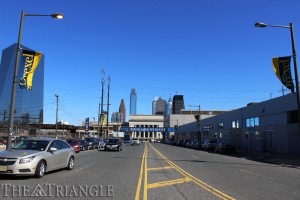Further expanding its eastern borders, Drexel University will soon begin work on a planned “Innovation Neighborhood” for startup businesses and academic buildings alike adjacent to the train tracks at 30th Street Station.

Representatives from the University have been hearing design proposals for the area, and construction is expected to begin within three years. Work is expected to continue over the next 15 to 20 years as the University finds clients interested in occupying the space.
As part of the University’s strategic plan published in 2012, the neighborhood, which will cover an area of 12 acres stretching from Market Street to John F. Kennedy Boulevard and from 30th Street Station to University Crossings, will provide spaces for both the University and private businesses, with the hope that they will be in closer proximity to Drexel’s campus and co-op students.
According to Vice President of University Facilities Robert Francis, the neighborhood is modelled off of a similar area at the Massachusetts Institute of Technology called Kendall Square.
“It’s a physical place where we can have all of these things come together. Students, employers’ startup companies, established tech companies, faculty laboratories, just everybody all mixed together and generating exciting stuff,” Francis said.
Francis also explained that this isn’t the only Innovation Neighborhood planned, but that a second western neighborhood was a possibility if the University manages to acquire the site of University City High School.
“We would like, if we conclude this arrangement with the University City High School site, to rethink the whole mix and have an Innovation West and an Innovation East … so that [we can] bookend the traditional Drexel University City campus with these innovation clusters,” Francis said.
The neighborhoods will hopefully bring many co-op positions closer to campus for undergraduate students along with providing new laboratories for graduate students.
In addition to the corporate and lab spaces, new retail will also be part of the Innovation Neighborhood. Senior Vice President of Corporate Relations and Economic Development Keith Orris described the layout of the proposed building: “Retail on the first floor, another one or two floors up of Drexel academic programs, and then above that would be corporate tenants who wanted to locate in our neighborhood to be close to Drexel innovation programs, close to students for co-op and graduates to come work with them. That is the Innovation Neighborhood.”
In addition to firms that Drexel has established relationships with, Orris also said that he hopes the neighborhood will particularly attract new firms from outside Philadelphia that will “broaden our market and our innovation ecosystem.”
The University is currently in the process of finding firms and companies interested in bidding for the opportunity to design and build the Innovation Neighborhood.
In addition to the Innovation Neighborhood, the University is working closely with Amtrak and SEPTA on another project aimed at finding a way to utilize the airspace over the rail yards north of 30th Street Station. This will include a two and half year study of the area by engineers from multiple disciplines to assess the different options available.
Since the rail yard project and the Innovation Neighborhood are so close to each other, the University hopes to coordinate the adjacent to projects to assimilate them into the campus master plan.
“What’s great is that that planning and the planning for the Amtrak SEPTA Rail Yards will be occurring roughly at the same time,” Orris said.
Orris explained that the University wants to avoid the development of the Innovation Neighborhood in a way that would prohibit strategic connections to the development above the rail yards. “For instance,” Orris said, “we want to make sure that we don’t put a building or a feature that had it been five or 15 feet one way or the other, we would not be blocking the extension of a road, a street, a walkway or a park, so we have to make sure that they coordinate with one another.”
In addition to the 12 acres of the Innovation Neighborhood, the area over the train tracks comprises over 70 acres, a significant expansion of University City.

